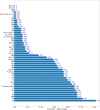Quantitative prediction of postpartum hemorrhage in cesarean section on machine learning
- PMID: 38872184
- PMCID: PMC11177388
- DOI: 10.1186/s12911-024-02571-7
Quantitative prediction of postpartum hemorrhage in cesarean section on machine learning
Abstract
Background: Cesarean section-induced postpartum hemorrhage (PPH) potentially causes anemia and hypovolemic shock in pregnant women. Hence, it is helpful for obstetricians and anesthesiologists to prepare pre-emptive prevention when predicting PPH occurrence in advance. However, current works on PPH prediction focus on whether PPH occurs rather than assessing PPH amount. To this end, this work studies quantitative PPH prediction with machine learning (ML).
Methods: The study cohort in this paper was selected from individuals with PPH who were hospitalized at Shijiazhuang Obstetrics and Gynecology Hospital from 2020 to 2022. In this study cohort, we built a dataset with 6,144 subjects covering clinical parameters, anesthesia operation records, laboratory examination results, and other information in the electronic medical record system. Based on our built dataset, we exploit six different ML models, including logistic regression, linear regression, gradient boosting, XGBoost, multilayer perceptron, and random forest, to automatically predict the amount of bleeding during cesarean section. Eighty percent of the dataset was used as model training, and 20 was used for verification. Those ML models are constantly verified and improved by root mean squared error(RMSE) and mean absolute error(MAE). Moreover, we also leverage the importance of permutation and partial dependence plot (PDP) to discuss their feasibility.
Result: The experiment results show that random forest obtains the highest accuracy for PPH amount prediction compared to other ML methods. Random forest reaches the mean absolute error of 21.7, less than 5.4 prediction error. It also gains the root mean squared error of 33.75, less than 9.3 prediction error. On the other hand, the experimental results also disclose indicators that contributed most to PPH prediction, including Ca, hemoglobin, white blood cells, platelets, Na, and K.
Conclusion: It effectively predicts the amount of PPH during a cesarean section by ML methods, especially random forest. With the above insight, ML predicting PPH amounts provides early warning for clinicians, thus reducing complications and improving cesarean sections' safety. Furthermore, the importance of ML and permutation, complemented by incorporating PDP, promises to provide clinicians with a transparent indication of individual risk prediction.
Keywords: Cesarean section; Machine learning; Partial dependence plot; Permutation importance; Postpartum hemorrhage; Random forest; Regression.
© 2024. The Author(s).
Conflict of interest statement
The authors declare no competing interests.
Figures












Similar articles
-
Prediction and Evaluation of Machine Learning Algorithm for Prediction of Blood Transfusion during Cesarean Section and Analysis of Risk Factors of Hypothermia during Anesthesia Recovery.Comput Math Methods Med. 2022 Apr 13;2022:8661324. doi: 10.1155/2022/8661324. eCollection 2022. Comput Math Methods Med. 2022. Retraction in: Comput Math Methods Med. 2023 Jun 28;2023:9863486. doi: 10.1155/2023/9863486. PMID: 35465016 Free PMC article. Retracted.
-
Development and validation of an artificial neural network prediction model for postpartum hemorrhage with placenta previa.Minerva Anestesiol. 2023 Nov;89(11):977-985. doi: 10.23736/S0375-9393.23.17366-4. Epub 2023 Jun 28. Minerva Anestesiol. 2023. PMID: 37378626
-
Machine learning-based prediction of postpartum hemorrhage after vaginal delivery: combining bleeding high risk factors and uterine contraction curve.Arch Gynecol Obstet. 2022 Oct;306(4):1015-1025. doi: 10.1007/s00404-021-06377-0. Epub 2022 Feb 16. Arch Gynecol Obstet. 2022. PMID: 35171347
-
Accuracy of machine learning and traditional statistical models in the prediction of postpartum haemorrhage: a systematic review.BMJ Open. 2025 Mar 3;15(3):e094455. doi: 10.1136/bmjopen-2024-094455. BMJ Open. 2025. PMID: 40032385 Free PMC article.
-
[Obstetric and anesthetic specificities in the management of a postpartum hemorrhage (PPH) associated with cesarean section].J Gynecol Obstet Biol Reprod (Paris). 2014 Dec;43(10):1104-22. doi: 10.1016/j.jgyn.2014.10.004. Epub 2014 Nov 4. J Gynecol Obstet Biol Reprod (Paris). 2014. PMID: 25447395 Review. French.
Cited by
-
A machine learning-based framework for predicting postpartum chronic pain: a retrospective study.BMC Med Inform Decis Mak. 2025 Apr 17;25(1):168. doi: 10.1186/s12911-025-03004-9. BMC Med Inform Decis Mak. 2025. PMID: 40247305 Free PMC article.
-
Development and Validation of An Interpretable Machine Learning-Based Prediction Model of Postpartum Hemorrhage in Placenta Previa Following Cesarean Section: A Multicenter Study.Reprod Sci. 2025 Aug 12. doi: 10.1007/s43032-025-01937-0. Online ahead of print. Reprod Sci. 2025. PMID: 40797059
References
-
- Anouilh F, de Moreuil C, Trémouilhac C, Jacquot M, Salnelle G, Bellec V, Touffet N, Cornec C, Muller M, et al. Family history of postpartum hemorrhage is a risk factor for postpartum hemorrhage after vaginal delivery: results from the French prospective multicenter Haemorrhages and Thromboembolic Venous Disease of the Postpartum cohort study. Am J Obstet Gynecol MFM. Elsevier; 2023;5(9):101062. - PubMed
-
- Yang F, Wang H, Shen M. Effect of preoperative prophylactic intravenous tranexamic acid on perioperative blood loss control in patients undergoing cesarean delivery: a systematic review and meta-analysis. BMC Pregnancy Childbirth. 2023;23(1):1–16. doi: 10.1186/s12884-023-05753-9. - DOI - PMC - PubMed
-
- Organization WH, et al. WHO recommendations Uterotonics for the prevention of postpartum haemorrhage: web annex 7: choice of uterotonic agents. World Health Organization; 2018. - PubMed
-
- Alkema L, Chou D, Hogan D, Zhang S, Moller AB, Gemmill A, et al. Global, regional, and national levels and trends in maternal mortality between 1990 and 2015, with scenario-based projections to 2030: a systematic analysis by the UN Maternal Mortality Estimation Inter-Agency Group. Lancet. 2016;387(10017):462–474. doi: 10.1016/S0140-6736(15)00838-7. - DOI - PMC - PubMed
MeSH terms
Grants and funding
- 22377766D/critical research and development program of Hebei Province
- 22377766D/critical research and development program of Hebei Province
- 22377766D/critical research and development program of Hebei Province
- 22377766D/critical research and development program of Hebei Province
- 22377766D/critical research and development program of Hebei Province
LinkOut - more resources
Full Text Sources
Medical

